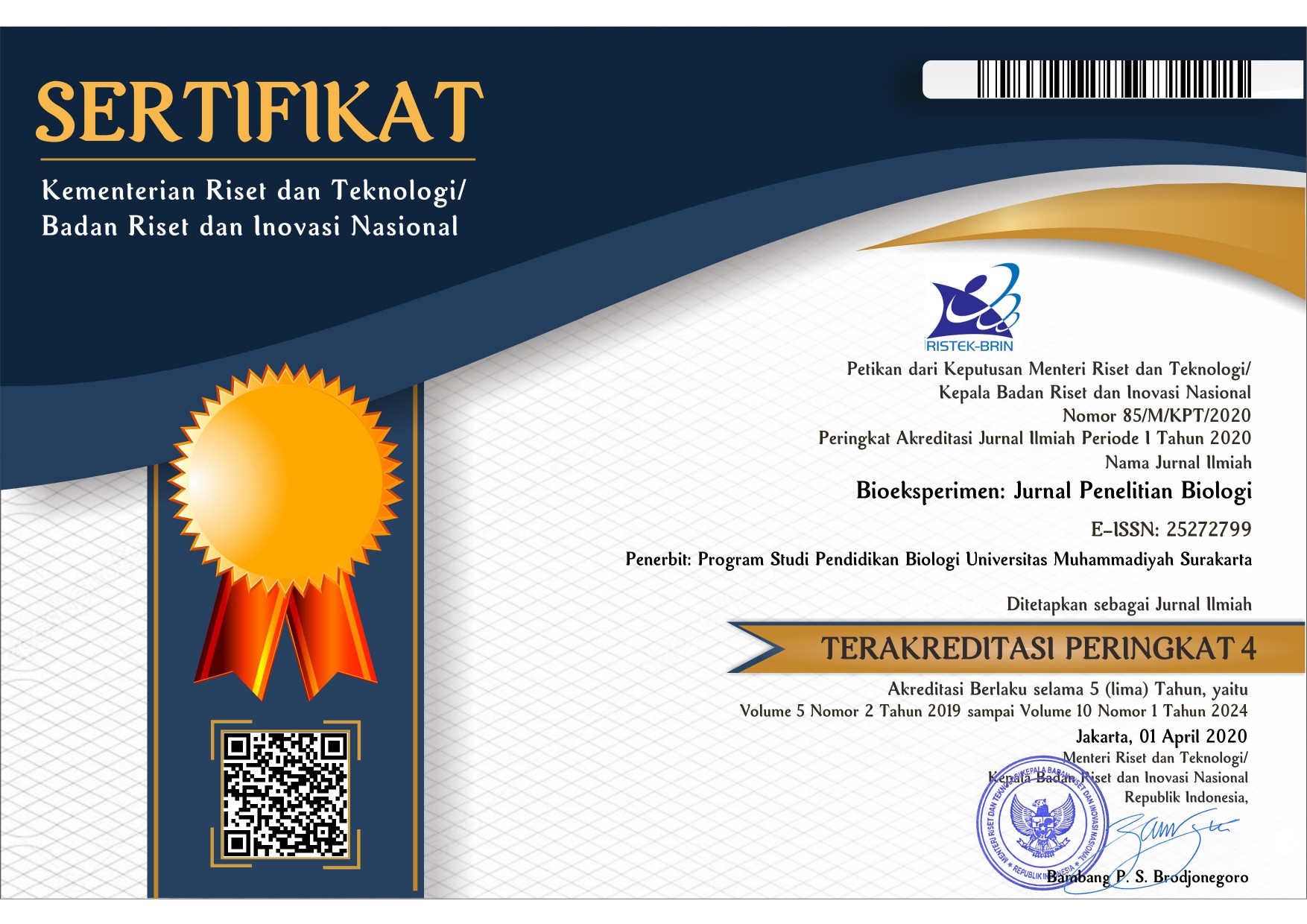Validasi Berat Ikan Pada Produk Olahan Ikan Dalam Kemasan Kaleng Di Surakarta
Setyaningrum Rahmawaty(1*), Dita Ayu Setyaningtyas(2)(1) Department of Nutrition Science Universitas Muhammadiyah Surakarta
(2)
(*) Corresponding Author
Abstract
Keywords
Full Text:
PDF (Bahasa Indonesia)References
Amiano, P., Dorronsoro, M., M. de Renobales et al. 2001. Very-long-chain ω-3 fatty acids as markers for habitual fish intake in a population consuming mainly lean fish: the EPIC cohort of Gipuzkoa. Eur J Clin Nutr. 55:827-832.
Badan Standardisasi Nasional. 2006. SNI ikan tuna dalam kaleng 01-2712.1-2006. Disitasi 7 Januari 2020. academia.edu/13159738/SNI_Tuma_Kaleng.
Baró, L., Fonallá, J., Peña, J.L. et al. 2003. n-3 fatty acids plus oleic acid supplemented milk reduces total and LDL cholesterol, homocysteine and levels of endothelial adhesion molecules in healthy humans. Clin Nutr. 22:175-182.
Burdge, G.C., Finnegan, Y.E., Minihane, A.M. et al. 2003. Effect of altered dietary n-3 fatty acid intake upon plasma lipid fatty acid composition, conversion of [13 C]α-linolenic acid to longer-chain fatty acids and partitioning towards β-oxidation in older men. Br J Nutr. 90:311-321.
CODEX Standard for Canned Tuna and Bonito (adopted 1981, revision 1995, amendments 2011), 2013. Disitasi 6 Mei 2019. www.fao.org/input/download/standards/105/CXS_070e.pdf
Dirjen PDSPKP. 2017. Gerakan memasyarakatkan makan ikan. Disitasi 6 September 2018. http://gizi.depkes.go.id/peringatan-hari-gizi-nasional-ke-57-tahun-2017/gemarikan-kemenkes-250117
Emken, E.A., Adlof, R.O., Gulley, R.M. 1994. Dietary linoleic acid influences desaturation and acylation of deuterium-labeled linoleic and linolenic acids in young adult males. Biochim Biophys Acta. 1213:277-288.
Garg, M.L., Blake, R.J., Clayton, E. et al. 2007. Consumption of an n-3 polyunsaturated fatty acid-enriched dip modulates plasma lipid profile in subjects with diabetes type II. Eur J Clin Nutr. 61:1312-1317.
Gillingham, L.G., Caston, L., Leeson, S. et al. 2005. The effects of consuming docosahexaenoic acid (DHA)-enriched eggs on serum lipids and fatty acid composition in statin-treated hypercholesterolemic male patients. Food Res International. 38:1117-1123.
Murphy, K., Meyer, B.J., Mori, T.A. et al. 2007. Impact of foods enriched with omega-3 long chain polyunsaturated fatty acids on erythrocyte omega-3 levels and cardiovascular risk factors. Br J Nutr. 97:749-757.
Neale, E., Probst, Y., Batterham, M. et al. 2011. Development and validation of an Australian database for estimating the seafood content of canned products. Food Nutr Sci. 2(7):759-763.
Oddy, W.H., Sherriff, J.L., Kendall, G.E. et al. 2004. Patterns of fish consumption and level of serum phospholipid very-long-chain omega-3 fatty acids in children with and without asthma, living in Perth, Western Australia. Nutr Diet. 61:30-37.
Pawlosky, R.J., Hibbeln, Novotny, J.A. et al. 2001. Physiological compartmental analysis of α-linolenic acid metabolism in adult humans. J Lipid Res. 42:1257-1265.
Rahmawaty, S., Charlton, K., Lyons-Wall, P. et al. 2013. Dietary intake and food sources of omega-3 long chain EPA, DPA and DHA of Australian children. Lipids. 48:869-877.
Rahmawaty, S. dan Meyer, B.J. 2020. Review: Stunting is a recognised problem: evidence for the potential benefits of omega-3 long chain polyunsaturated fatty acids. Nutrition. 73:1-13.
Sioen, I., Huybrechts, I., Verbeke, W. et al. 2007. n-6 and n-3 PUFA intakes of pre-school children in Flanders, Belgium. Br J Nutr. 98:819-825.
Tehubijuluw, Hellna, Fransina et al. 2013. Penenetuan Kandungan Logam Cd dan Cu Dalam Produk Ikan Kemasan Kaleng Secara Spektrofotometri Serapan Atom (SSA). OJS. 1(1):9-3.
Vlaardingerbroek, H., Hornstra, G., de Koning, T.J. et al. 2006. Essential polyunsaturated fatty acids in plasma and erythrocytes of children with inborn errors of amino acid metabolism. Mol Genet Metab. 88:159-165.
Yep, Y.L., Li, D., Mann, N.J. et al. 2002. Bread enriched with microencapsulated tuna oil increases plasma docosahexaenoic acid and total omega-3 fatty acids in humans. Asia Pac J Clin Nutr. 11:285-291.
Article Metrics
Abstract view(s): 601 time(s)PDF (Bahasa Indonesia): 394 time(s)
Refbacks
- There are currently no refbacks.








